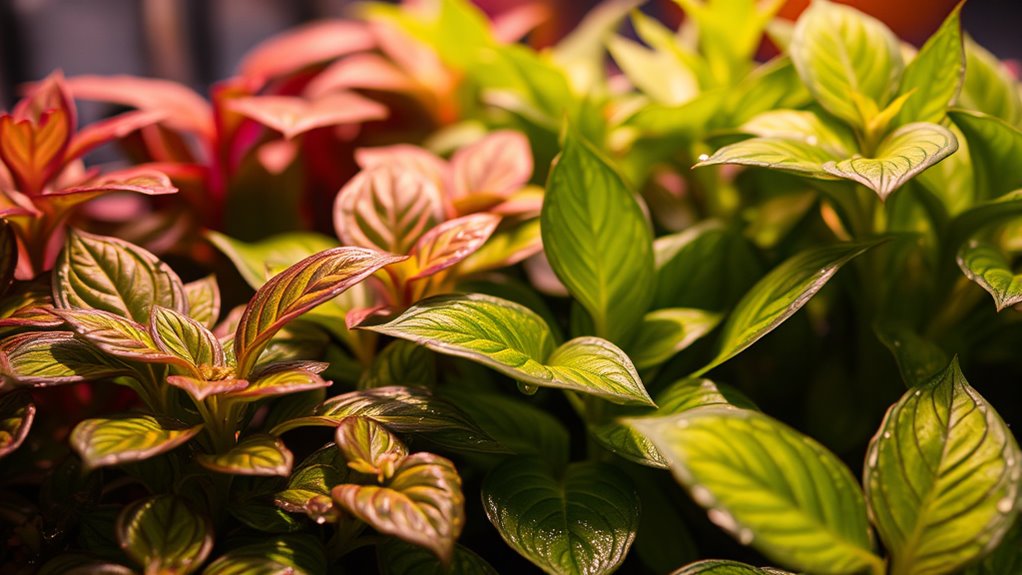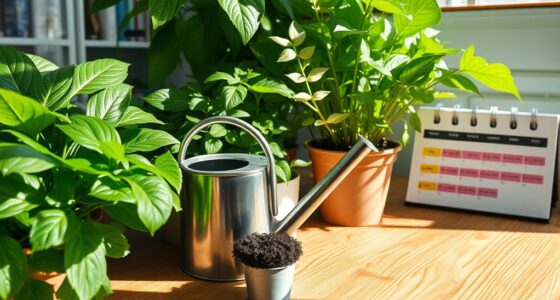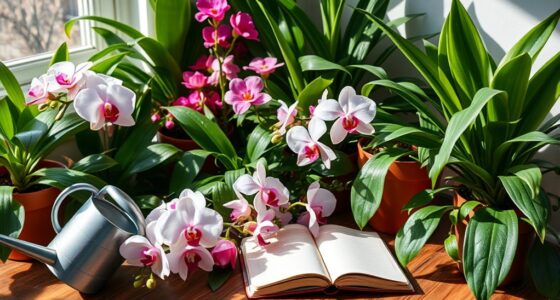To keep your indoor plants thriving, you should typically have your grow lights on for 8 to 18 hours a day, depending on the species and their growth stage. Seedlings usually need 14 to 18 hours of light, while mature plants require 6 to 8 hours. Remember, at least 6 hours of darkness is essential to prevent leggy growth. There’s more you should know to optimize light settings effectively for your plants’ health.
Key Takeaways
- Most indoor plants thrive with 8 to 18 hours of light daily, depending on their growth stage.
- Seedlings generally require 14 to 18 hours of light, while autoflowering strains may need 20-24 hours.
- Mature plants benefit from 6 to 8 hours of bright, indirect light each day.
- During flowering, reduce light to a 12-hour cycle to mimic natural conditions.
- Use timers to ensure consistent light exposure and prevent stress on the plants.
Understanding Plant Light Requirements
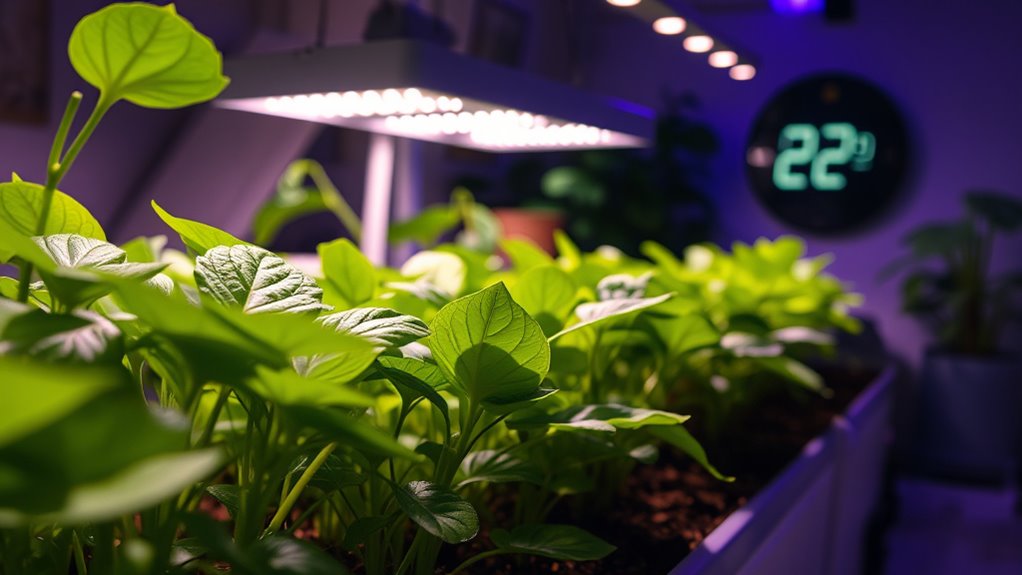
What do your plants really need when it comes to light? To thrive, they require light in the 400 to 700 nm range, known as Photosynthetically Active Radiation (PAR).
Different wavelengths affect growth differently; blue light encourages lush leaves, while red light promotes flowering and fruiting. Additionally, color accuracy plays a role in how effectively plants utilize light, as different colors can influence their growth patterns. To enhance your indoor gardening experience, consider using portable grow lights that are designed for optimal performance in various home settings.
You should measure your plants’ light needs using Daily Light Integral (DLI) and Photosynthetic Photon Flux Density (PPFD). These metrics help you understand the total light your plants receive and its intensity. Keep in mind that each species has unique light requirements based on their natural habitats, and light measurements and ratings can provide valuable insights into their specific needs. Creating your own backyard greenhouse can also help you control the lighting conditions more effectively. Using a light meter can help you adjust light levels, ensuring your plants get what they need for optimal growth and health.
Optimal Light Duration for Seedlings
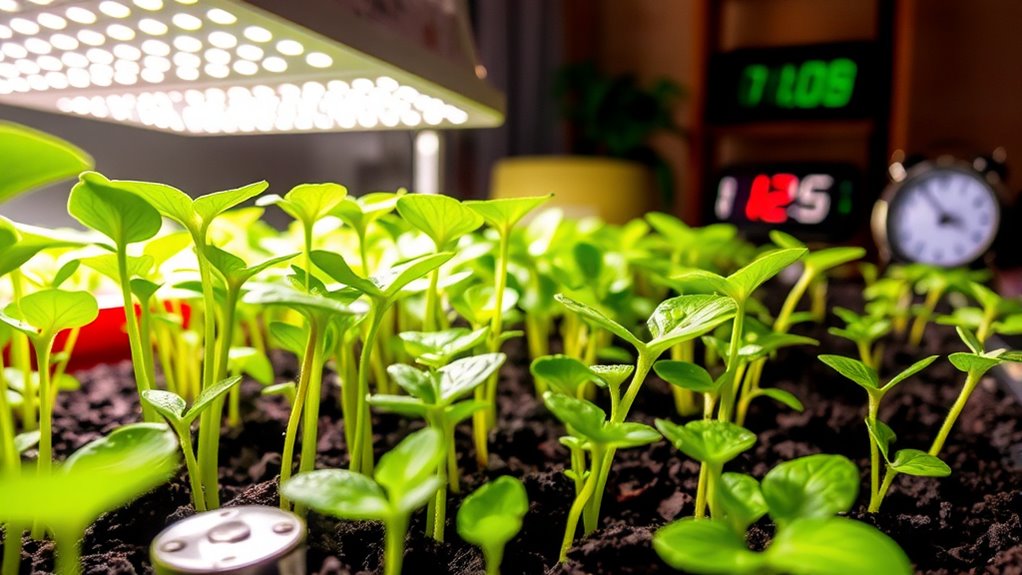
Generally, seedlings thrive with 14 to 18 hours of light each day. Depending on the plant type, you might need to adjust this duration; autoflowering strains often require 20-24 hours. It’s essential to provide at least 6 hours of darkness, too, to prevent leggy growth. As your seedlings mature, gradually increase their light exposure while monitoring their response. Controlled light exposure allows for precise management of duration and intensity, optimizing growth conditions. Additionally, providing a diversification of retirement portfolio through various growth strategies can enhance your overall success in gardening. The art of decluttering spaces by organizing your gardening tools and supplies can also create a more efficient workspace.
Seedlings generally thrive with 14 to 18 hours of light daily, while autoflowering strains may need 20-24 hours.
To create a more soothing environment for your plants, consider using natural materials that can enhance your indoor gardening experience.
Using timers can help maintain a consistent schedule, and full-spectrum lights ensure your seedlings get the necessary intensity.
Light Needs for Mature Plants

While mature plants generally thrive on 6-8 hours of bright, indirect light each day, their specific light needs can vary greatly depending on the species. Some plants flourish in full sun, while others do best in low-light conditions. As plants mature, they often require less intense light than they did as seedlings. Light intensity impacts plant health, so it’s essential to monitor their exposure to ensure they receive the appropriate amount of light. Additionally, providing a balanced diet rich in essential nutrients can support their overall growth and development. Understanding the importance of emergency preparedness essentials can also play a critical role in ensuring your plants survive during unexpected disruptions. Natural sunlight is ideal, but artificial lights like LED grow lights can effectively supplement it. The direction of light also matters; plants facing south typically receive more intense light than those facing north. Moreover, incorporating aquatic exercises into your routine can enhance your physical health, supporting your gardening efforts by improving your strength and endurance.
The Role of Light Intensity and Spectrum
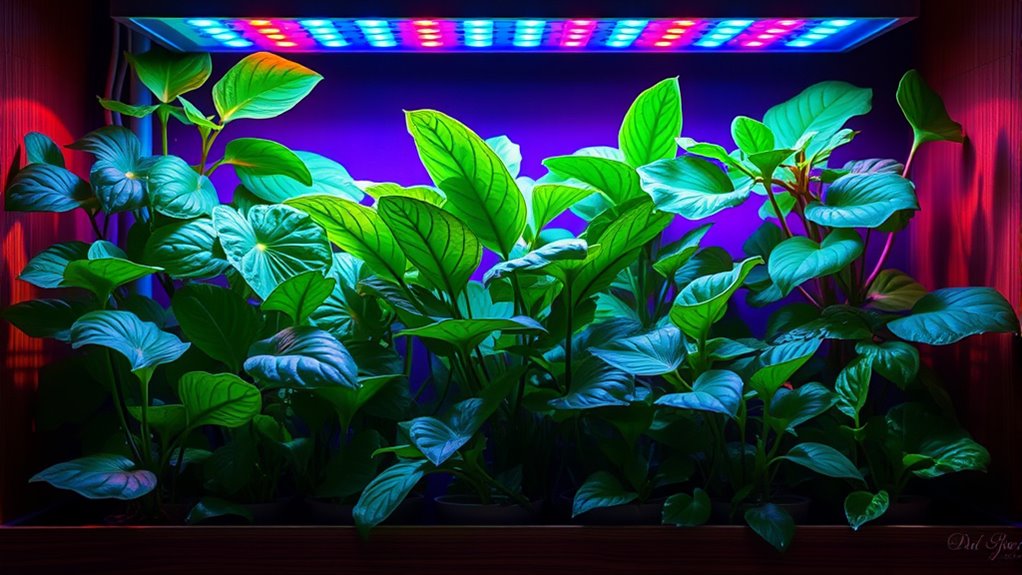
Light intensity and spectrum play crucial roles in the health and growth of your indoor plants. High light intensity encourages compact growth and strong stems, while low intensity can lead to weak, leggy plants. Measure intensity in footcandles (FC); low-light plants thrive at 25-100 FC, medium-light plants at 100-500 FC, and high-light plants at 500-1000 FC. Proper light spectrum balance is needed for different growth stages, ensuring that plants receive the appropriate wavelengths for optimal development. Engaging with plants under specific light conditions can enhance imaginative play, fostering creativity and exploration similar to the benefits seen with Waldorf toys. Furthermore, maintaining indoor air quality is essential, as it supports healthy plant growth and minimizes the presence of harmful pollutants. Using self-watering pots can also help maintain consistent moisture levels, which is vital for plant health.
The light spectrum also matters. Blue light promotes vegetative growth, while red light stimulates flowering. Using full-spectrum LED grow lights mimics natural sunlight, providing a balanced spectrum essential for both growth stages.
Adjusting Light Duration for Growth Stages
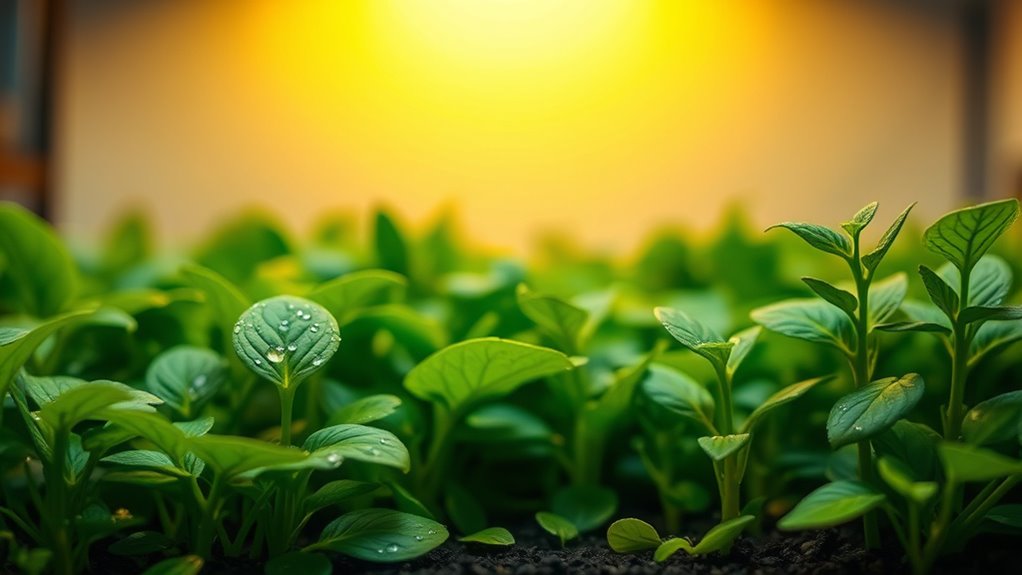
To ensure your indoor plants thrive, it’s essential to adjust light duration according to their specific growth stages.
Seedlings need 16 to 18 hours of light daily to prevent legginess and strengthen their roots and stems. Don’t forget to provide at least 6 hours of darkness for their metabolic activities. Light duration is crucial for achieving optimal growth in seedlings, as it significantly influences their overall health. Emotional dysregulation can also impact a plant’s growth if environmental stressors are not managed properly. Additionally, maintaining a consistent budget for plant care can help ensure you have the necessary resources for proper lighting and equipment. Using essential oils such as lavender oil can help create a calming environment that may indirectly benefit plant growth by reducing stressors.
During the vegetative stage, maintain the same 16 to 18 hours to promote robust foliage development, with some plants thriving on 24 hours of light in hydroponic setups.
As your plants transition to flowering, reduce light to 12 hours per day to simulate autumn, encouraging blooming.
Always consider plant species and environmental factors, and adjust light schedules based on how your plants respond to their conditions.
Benefits of Using Timers for Grow Lights
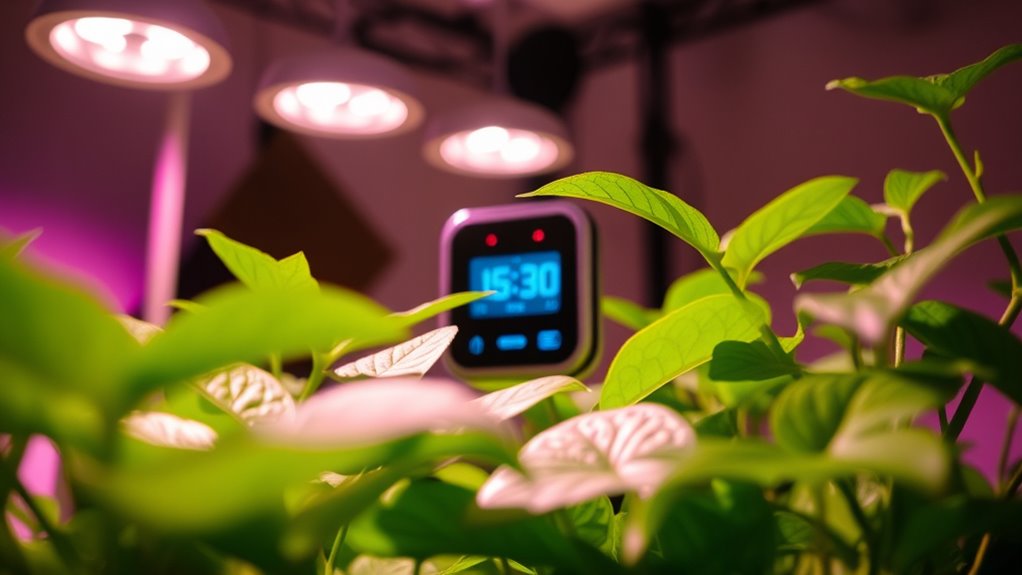
Using timers for grow lights not only simplifies your indoor gardening routine but also enhances plant health and productivity. They maintain consistent light cycles, crucial for regulating your plants’ physiological processes like photosynthesis and nutrient uptake. With reduced stress from predictable lighting, your plants grow healthier and develop balanced growth patterns. Timers optimize photosynthesis, boosting energy production and increasing overall productivity, including better flowering and fruiting. Moreover, automated timers save you time and effort, eliminating the need for manual switching. They also help lower utility bills by ensuring lights are off during unnecessary periods, aligning with eco-friendly gardening practices. Additionally, proper light exposure is vital for preventing stunted growth and ensuring successful flowering in your plants. Incorporating educational toys into your gardening routine can also enhance your learning experience about plant care and the importance of light cycles. Furthermore, adopting nutrient-dense practices like adding chia seeds to your gardening regimen can support overall plant health and vitality. Understanding the impact of bee stewardship on local ecosystems can also inspire more sustainable gardening choices.
Risks of Overexposure to Light

Although grow lights are essential for indoor plants, overexposure to light can create significant risks that threaten their health. You might notice leaf damage, like scorched edges or discoloration, which indicates stress from excessive light. This overexposure accelerates soil drying, leading to wilting and dehydration. Plants may also exhibit stunted growth and a loss of vibrant colors, turning pale or yellow. Additionally, continuous light disrupts their respiratory processes, causing hormonal imbalances and increasing susceptibility to pests and diseases. Regular filter replacement is crucial for maintaining a healthy environment, so you’ll want to watch for wilting leaves and soil that dries out too quickly. Moreover, just like whole fruits promote better health outcomes compared to juices, ensuring an optimal light balance is essential for your plants’ vitality. Most houseplants thrive in low to moderate light, so by understanding these risks, you can better manage your plant’s light exposure and ensure they thrive indoors. It’s important to remember that similar to RMDs for retirement accounts, plants also require a balanced approach to their light intake to flourish effectively.
Special Considerations for Different Plant Types
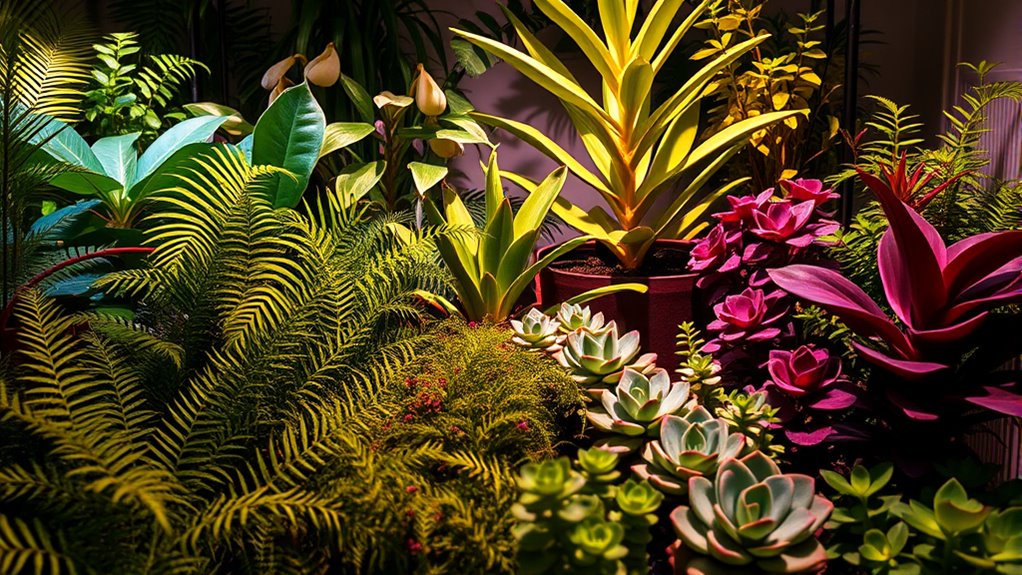
Managing light exposure isn’t just about avoiding overexposure; it also involves understanding the specific needs of different plant types.
For seedlings, aim for 14-16 hours of light to encourage strong root and stem development. Healthy breakfast is important in maintaining overall plant health, so consider the nutritional needs of your plants as well. Incorporating low-carb options in your plant care routine can help ensure they receive essential nutrients. Additionally, proper cold medications may be necessary if you’re handling plant-related allergies. Mature plants generally thrive with 8-12 hours. If you’re growing flowering plants, a 12-hour light and 12-hour dark cycle is essential. Mature plants have reduced light needs during their established growth phase, so adjust accordingly.
Vegetative plants benefit from 14-16 hours of light, while fruiting plants prefer longer periods, but don’t exceed 18 hours. Consider the light spectrum too; blue light promotes vegetative growth, while red light encourages flowering. Additionally, adjust light intensity based on your plant’s growth stage.
Monitoring Plant Response to Light Settings

Monitoring your plants’ response to light settings is crucial for their overall health and growth. Look for signs of stress, like wilting or yellowing leaves, as these often indicate improper light conditions.
Monitoring your plants for signs of stress, such as wilting or yellowing leaves, is essential for their health and growth.
Regularly check your plants to catch any signs of light burn. If you notice stress, consider raising your lights to reduce intensity. Ensure your setup has adequate ventilation to maintain a comfortable environment. Full-spectrum lights are particularly beneficial as they mimic natural sunlight, supporting optimal plant development.
Most plants thrive with 8-18 hours of light daily, requiring at least 6 hours of darkness. Adjust light duration based on growth stages: 12-16 hours during vegetative, and 8-12 hours during flowering.
Use timers for consistency and monitor light intensity with PAR meters to optimize your plants’ growth.
Frequently Asked Questions
Can I Use Natural Sunlight Instead of Grow Lights?
Yes, you can use natural sunlight instead of grow lights, but it depends on your plants’ needs.
Sunlight provides a full spectrum of light that promotes healthy growth, but its intensity and availability vary by location and season.
If your plants thrive in bright conditions, they’ll likely do well with sunlight alone.
However, during low-light seasons, you might want to supplement with grow lights to ensure they get enough energy for optimal growth.
How Do I Know if My Plants Need More Light?
Think of your plants like kids reaching for the cookies on a high shelf. If they’re stretching and leaning awkwardly, they’re telling you they need more light.
Look for signs like leggy growth, smaller leaves, or lopsided shapes. If they seem slow to grow or lose their vibrant colors, it’s time to boost their light levels.
Monitoring these signs ensures your green friends thrive in their indoor space, just like those cookies!
What Happens if I Forget to Turn off the Grow Lights?
If you forget to turn off the grow lights, your plants can experience stress from prolonged exposure.
This stress might lead to issues like leaf burn or stunted growth. While some plants can recover from short periods of excess light, continuous exposure can be detrimental, especially for photoperiod plants.
They may even suffer from revegetation shock. To avoid this, consider using timers to maintain a consistent light schedule.
Can Different Types of Plants Share the Same Light Schedule?
Imagine hosting a dinner party where some guests prefer appetizers while others crave desserts. Just like that, different plants have unique light needs.
You can share light schedules if their requirements align, like lettuce and spinach thriving on 10-12 hours. However, short-day and long-day plants may clash.
To keep everyone happy, use adjustable timers or separate areas. Observing how your plants respond ensures they’re all getting the right light love they need!
How Do I Adjust Light Settings for Seasonal Changes?
To adjust light settings for seasonal changes, you should monitor your plants closely.
In spring, increase light duration and intensity as they start to grow.
During summer, ensure they get enough water due to stronger light.
In autumn, gradually reduce light and watering as days shorten.
In winter, supplement with grow lights to maintain 8-10 hours of light.
Regularly check for signs of stress to keep your plants thriving year-round.
Conclusion
In conclusion, finding the right balance for your grow lights is like fine-tuning a musical instrument; each plant has its unique melody. By adjusting light duration according to growth stages and specific needs, you can create a harmonious environment for thriving greenery. Remember, just as a musician wouldn’t play a note too long, your plants shouldn’t be overexposed to light. Keep an eye on their response, and you’ll soon master the art of indoor gardening.

